One of the finest holiday specials ever created hits the half-century mark this year, so here’s a fresh look at the flawless soundtrack that played such a major part in its success.
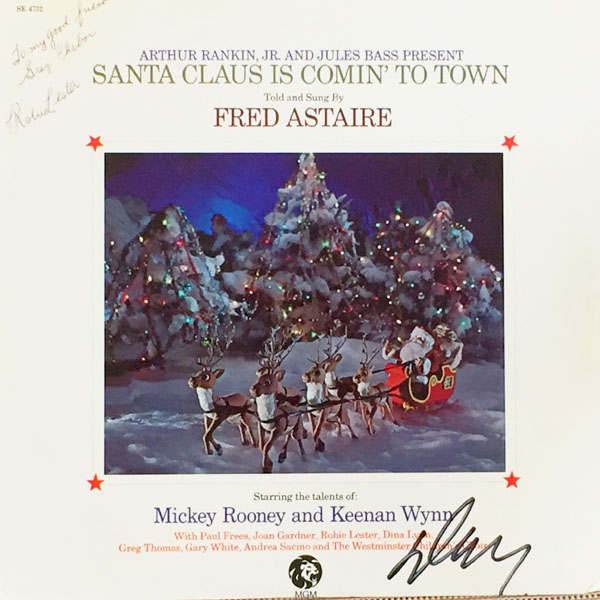
Arthur Rankin, Jr. and Jules Bass Present
SANTA CLAUS IS COMIN’ TO TOWN
Complete Original TV Soundtrack
MGM Records SE-4732 (12” 33 1/3 RPM Mono–Enhanced for Stereo / 1970)
CD Reissue: Rhino Records R2-76102 (1989 / Paired with Frosty the Snowman)
Released in 1970. Album Producers: Maury Laws, Jules Bass. Film Producer/Directors: Arthur Rankin, Jr., Jules Bass. Original Story and Teleplay: Romeo Muller. Sound Engineers: John Boyd, Jim Harris, Phil Kaye, Bob Elder. Sound Effects: Tom Clack. Musical Director: Maury Laws. Cover Design: Norbert Jobst, Maurer Productions West. Running Time: 51 minutes.
Voices: Fred Astaire (Special Delivery “S.D.” Klueger); Mickey Rooney (Kris Kringle); Keenan Wynn (Winter Warlock); Robie Lester (Miss Jessica); Paul Frees (Burgermeister Meisterburger, Grindsley, Baby Claus, Assorted Kringles, Guard, Father, Opening Announcer, Scrooge, Businessman); Joan Gardner (Tanta Kringle, Lady in Store); Dina Lynn, Andrea Sacino, Gary Thomas, Jeff Thomas (Children); The Westminster Children’s Choir, The Mike Sammes Singers.
Songs: “Santa Claus is Comin’ to Town” by Haven Gillespie, J. Fred Coots; “The First Toymaker to the King,” “Be Prepared to Pay,” “Put One Foot in Front of the Other,” “What Better Way to Tell You” by Maury Laws, Jules Bass.
 During a rare interview in a 2002 collection of animation essays called The Cartoon Music Book, legendary Rankin/Bass composer/arranger Maury Laws told your author that among the Rankin/Bass specials, Santa Claus is Comin’ to Town was his personal favorite. “I think, with that special, we hit everything right,” he told me. “[Mickey Rooney] had the right quality for what we needed. Keenan Wynn was very good, too.”
During a rare interview in a 2002 collection of animation essays called The Cartoon Music Book, legendary Rankin/Bass composer/arranger Maury Laws told your author that among the Rankin/Bass specials, Santa Claus is Comin’ to Town was his personal favorite. “I think, with that special, we hit everything right,” he told me. “[Mickey Rooney] had the right quality for what we needed. Keenan Wynn was very good, too.”
His estimation surely matches those of countless viewers who have continued to keep this special one of the longest-running in history. While not sustaining a continuous network run like Rudolph, the Red-Nosed Reindeer, it nevertheless enjoys ongoing broadcasts in syndication, cable and various video releases, often on multiple platforms within the same season.
By 1970, Rankin/Bass was beginning to establish its identity as the foremost producer of holiday specials. The company was at a creative peak, with Saturday morning shows in competition with Hanna-Barbera, Filmation and DePatie-Freleng, and several theatrical features already on their resume.

Santa Claus is Comin’ to Town benefits from everything learned in the years following the success of Rudolph. It was lavish and spectacular without but it wasn’t too ambitious for its means like the lovely but unsuccessful 1996 feature, The Daydreamer. But like that feature, it offers an solid musical score by Laws and co-producer/director Jules Bass that includes the memorable “Put One Foot in Front of the Other,” a song that some do not realize originated with this film.
The following video was presented in honor of Maury Laws at the annual Animation Guild memorial of those in the animation industry who left us the previous year. It took place at the Local 839 location in Burbank (this is the historic guild mentioned in the end credits of The Bugs Bunny/Road Runner Show.
Santa Claus is Comin’ to Town was produced during a transitional era when it was possible to combine Golden Age stars, voice acting veterans and some of the best studio singers in the world. Fred Astaire proves just as elegant and engaging off-camera as he was on. The aforementioned Rooney can be a polarizing figure to some, but his “Shatneresque” quality works well for the character of young Kris Kringle—a brash, good-natured, foolhardy fellow who was essentially the “put on a show” persona from Rooney’s early MGM movies. Paul Frees turned in a buffet of great roles, doing three at a time in one scene playing the Burgermeister, Grindsley and Baby Claus.
“One of the things Jules and I always did was to make the celebrities comfortable with the material,” Maury said. “We wrote the songs just for them. Performers like Fred Astaire and Danny Thomas could sing, of course, but we would be aware of their limitations and never give them vocal gymnastics. I think, for that reason, the stars always liked what we created for them. We never had anyone come back to us later and say they didn’t like a song.”
Rounding out the cast was the underappreciated Joan Gardner with a fine children’s speaking and singing cast—plus the uncredited Mike Sammes Singers heard in “First Toymaker to the King.”
And then there’s Robie Lester in her signature role as Jessica, the singer/actress who read stories to millions of kids as the original Disneyland Story Reader, sang for Eva Gabor in two Disney features; looped endless dialogue for movies and TV, and had a pitch-perfect voice gracing more Disney records than any other performer. Hers is a young Ms. Claus, a woman on her own in a little town—it’s a quiet village, every day like the day before—who belts out “My World is Beginning Today” as no one else could.
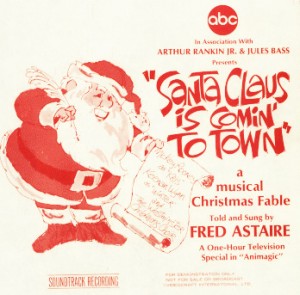 Rankin/Bass had a promotional recording pressed of Santa Claus is Comin’ to Town with cover art by Paul Coker, Jr. The commercially released version appeared on MGM’s record label (MGM also released Frosty the Snowman as an LP). The MGM packaging claims that it is stereo, but there is no two-channel separation. Whatever stereo rechanneling MGM might have done was minimal and did not harm the integrity of the recording.
Rankin/Bass had a promotional recording pressed of Santa Claus is Comin’ to Town with cover art by Paul Coker, Jr. The commercially released version appeared on MGM’s record label (MGM also released Frosty the Snowman as an LP). The MGM packaging claims that it is stereo, but there is no two-channel separation. Whatever stereo rechanneling MGM might have done was minimal and did not harm the integrity of the recording.
Like so many Rankin/Bass TV soundtracks, the entire production of Santa Claus is Comin’ to Town works perfectly as pure audio on the 1970 MGM record. There is very little lost without the visuals, nice as they are. It is neither padded nor rushed. The music is a constant joy from beginning to end. There have been many excellent tributes and parodies of the Rankin/Bass style (Jon Favreau’s Elf is an especially unabashed love letter), but like Carl Stalling’s music in Warner cartoons, reproducing the Rankin/Bass “house sound” that Laws created is just as challenging as recreating the look and feel.
Speaking of Jon Favreau, he speaks on camera about Rankin/Bass in the documentary “The Animagic World of Rankin/Bass,” along with our own Jerry Beck with Mark Evanier (Garfield and Friends); the Chiodo brothers (Elf), Chris Butler (Paranorman); Lee Mendelson (Peanuts, Garfield), Mark Caballero (Spongebob Squarepants); Brenda Chapman (Brave) and Kevin Lima (Tarzan). It’s a special feature on the 2018 Santa Claus is Comin’ to Town DVD or Blu-ray (as well as Frosty the Snowman and Rudolph) remastered releases from Universal.
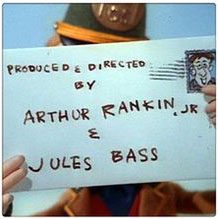 The first broadcast was on Monday, December 14th, 1970, pre-empting the short-lived drama The Young Lawyers. It competition was the fading Rowan & Martin’s Laugh-In and the long-running Gunsmoke on CBS. One of its sponsors was Parker Brothers.
The first broadcast was on Monday, December 14th, 1970, pre-empting the short-lived drama The Young Lawyers. It competition was the fading Rowan & Martin’s Laugh-In and the long-running Gunsmoke on CBS. One of its sponsors was Parker Brothers.
Santa Claus is Comin’ to Town is truly a special among specials. It combines the best Rankin/Bass elements: genuine warmth; memorable characters that could be silly but not ridiculous; songs that advanced the story but stood on their own and a superb cast.
It’s also one of the few in which the narrator speaks to the audience at the end, presumably the adults, about everyone’s ambivalence about the holiday season and in essence, about the state of life itself. Why do crummy things happen and why should we be optimistic? Fred Astaire was never so graceful as he explains it (as Romeo Muller so beautifully wrote it), yet he isn’t dancing a step.
Jerry Beck adds: “I like that Greg did the DVD/blu-ray audio track commentary and talked like crazy for 51 straight minutes in one take. That’s a testament to how great this special is.”
“Put One Foot in Front of the Other” – Mickey Rooney and Keenan Wynn
One of the memorable songs from the special. The music was recorded in England with The Mike Sammes Singers, one of the world’s foremost vocal groups. They also sang with The Beatles, Frank Sinatra, Barbra Streisand and even Bette Davis.
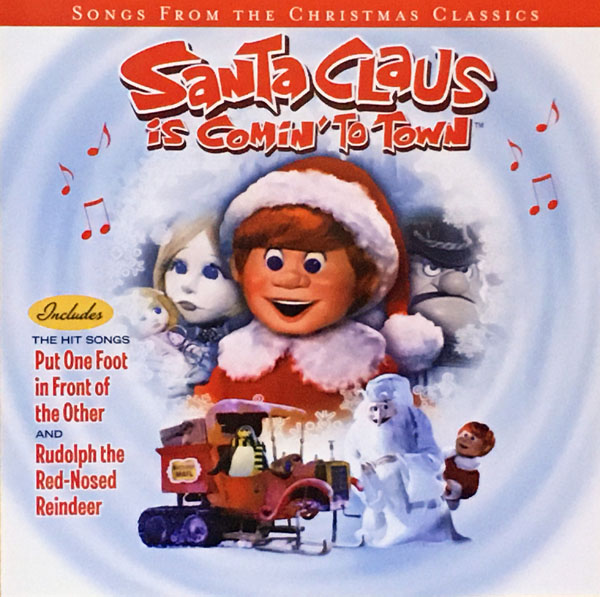
SANTA CLAUS IS COMIN’ TO TOWN
and RUDOLPH, THE RED-NOSED REINDEER
Songs from the Christmas Classics
The Silver and Gold Singers
Classic Media #70011 (Compact Disc)
Released in 2003. Running Time: 29 minutes.
“Santa Claus is Comin’ to Town” Songs: “Santa Claus is Comin’ to Town” by Haven Gillespie, J. Fred Coots; “The First Toymaker to the King,” “Put One Foot in Front of the Other,” “No More Toymakers to the King,” by Maury Laws, Jules Bass.
“Rudolph the Red-Nosed Reindeer” Songs: “Rudolph the Red-Nosed Reindeer, Jingle Jingle Jingle,” “We’re a Couple of Misfits.” “There’s Always Tomorrow,” “Silver and Gold,” “The Most Wonderful Day of the Year,” “A Holly Jolly Christmas,” “Fame and Fortune” by Johnny Marks.
A genuine curio, this album was released by the company that owns the Rankin/Bass pre-1971 specials and all the characters of that time except Rudolph himself (that’s a little more complicated). Some stores sold alongside holiday merchandise, like candy and wrapping paper. Quite often retailers will place music products in holiday-themed aisles as impulse-buy items.
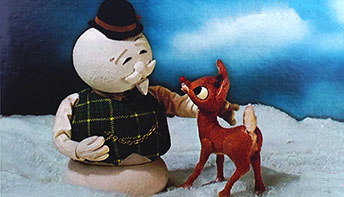 “The Silver and Gold Singers” are a clearly a fictional studio group (unless they’ve been touring and someone has seen them). Their sprightly, bell-clear style puts one in the mind of youthful, exuberant “Kids of the Kingdom” theme park singers, all polished and with fine range. The songs work best when sung by the complete ensemble because it draws less attention to the fact that these are far from the originals.
“The Silver and Gold Singers” are a clearly a fictional studio group (unless they’ve been touring and someone has seen them). Their sprightly, bell-clear style puts one in the mind of youthful, exuberant “Kids of the Kingdom” theme park singers, all polished and with fine range. The songs work best when sung by the complete ensemble because it draws less attention to the fact that these are far from the originals.
It’s interesting to hear the full Laws arrangements and orchestrations converted to electronic keyboards. It is quite an achievement in its way, and there are a few original flourishes here and there. The songs and the arrangements are so familiar that spotting any differences is easy and fun.
Even though Santa Claus is Comin’ to Town is the “hero” title of the combo, there are more Rudolph songs, including the “lost” tune, “Fame and Fortune.” In the days of live television, as well as radio, it was common to create new productions of the same special each year but make changes here and there to delight audiences, please sponsors and create interest. The NBC live presentation of Max Leibman’s Babes in Toyland, for example, had different elements in the two years it was done each time.
When TV “spectaculars” became pre-recorded, the practice of making changes to keep things fresh continued for a while. General Electric had two songs created and animated for Rudolph and Hermie to sing in successive years. One year, audiences would see and hear “We’re a Couple of Misfits” and the other year it changed to “Fame and Fortune” (while their individual “Why Am I Such a Misfit?” solos stayed intact). The Decca soundtrack album never included “Fame and Fortune.”
“Fame and Fortune”
This is the song that replaced the full version of “We’re a Couple of Misfits” in GE’s rebroadcast of Rudolph. CBS used this version in the ‘70s, then “Misfits” was restored. In the process, “Fame and Fortune” was mostly forgotten but this studio album manages to preserve at least one studio recording on disc.

MERRY MICKLEMAS
Mickey Rooney
Timic Productions MICKEY-100 (Stereo / 2015 / 12” 33 1/3 RPM LP)
Released in 1979. Producer: J. Michelle Scott, SRS Records. Engineers: Dave Chiodo, Jerry Musgrove. Mastering: Masterdisk, NYC. Photography: Andrea Alberts. Production Coordination: ERH Productions. Design, Graphics: Nina Leto. Recorded at SRS International Recording Studios, Fort Lauderdale, Florida. Running Time: 25 minutes
Songs: “Mr. Wha De Ya Want,” “Mickey’s New Year,” “The Gift” by Mickey Rooney; “The Christmas Song” by Mel Torme, Robert Wells; “White Christmas” by Irving Berlin; “Silver Bells” by Jay Livingston, Ray Evans; “These Things Mean Christmas to Me” by Jerry Hall; Merry Christmas and A Happy New Year,” “Christmas at Home” by Ralph Norman Elsmo; “Jingle Bells” (Traditional).
Back in the 1970s, a handful of legendary comedians and actors from the golden age found themselves in South Florida, which was touted as “Hollywood East” in the days of Flipper and The Jackie Gleason Show. Gleason himself made a successful transition; as an avid golfer, gentlemen of leisure and marketing genius, he settled into a high-end Fort Lauderdale golf suburb called Inverrary and lived out his life in grand style. Some became pitch person for housing developments and condominiums, such as Milton Berle’s Fairways of Tamarac, Eve Arden’s Polynesian Gardens in Plantation and Mike Douglas’ Bonaventure.
 While some very substantial movies and TV series were made in the Miami/Fort Lauderdale area over the decades, the ’60s and ’70s also yielded a crop of not-so-impressive beauts, some of which have become lucky enough to gain cult status, like Herschel Gordon Lewis’ Two Thousand Maniacs! filmed in St. Cloud (a rural community 30 minutes from Walt Disney World Resort). Filmed with ultra-low budgets, many Florida features, including Jerry Lewis’ Hardly Working were expected to revitalize careers but didn’t quite turn the entertainment world on its ear.
While some very substantial movies and TV series were made in the Miami/Fort Lauderdale area over the decades, the ’60s and ’70s also yielded a crop of not-so-impressive beauts, some of which have become lucky enough to gain cult status, like Herschel Gordon Lewis’ Two Thousand Maniacs! filmed in St. Cloud (a rural community 30 minutes from Walt Disney World Resort). Filmed with ultra-low budgets, many Florida features, including Jerry Lewis’ Hardly Working were expected to revitalize careers but didn’t quite turn the entertainment world on its ear.
Mickey Rooney spent several years making appearances in South Florida, including a stint as the “surprise” bag boy in local A&P commercials. He guested on talk programs like The Merv Griffin Show to promote his big plans with “the guys down in Lauderdale.” One of the fruits of his labor was a comedy called The Godmothers, in which he co-starred with Frank Fontaine and Jerry Lester. It’s easy and oh-so-tempting to diss these movies. But these former headliners had debts to pay and once-bright spotlights to chase.
Rooney fared much better on vinyl during this era. Not that this album is the best Christmas record of all time, but it is a well-produced, fully orchestrated time capsule starring a talented icon of moviedom’s glory days. He gives it his best shot, with ballads, wishes for peace, and a few character voices. Most of all he acts like Mickey Rooney, which was his specialty.
The album was recorded at SRS Recording studios, a small but well-appointed studio located in a nondescript warehouse district in the Oakland Park suburb of West Fort Lauderdale. Almost like a James Bond set, the outside was disarmingly dank, but the interior of producer Michelle Scott’s interior office was lush and opulent, with custom rockwork walls and plush amenities. Among the SRS projects were two discs for Peter Pan Records: Jaws of the Shark and The Singing American Cowboy.
“Merry Christmas and A Happy New Year”
A peppy tune with a melodic resemblance to Bing Crosby’s “Mele Kalikimaka”, this song was released the same year as Rudolph and Frosty’s Christmas in July, Rooney’s third and final turn as Santa for Rankin/Bass. This tune captures the same spirit and performance style.


 GREG EHRBAR is a freelance writer/producer for television, advertising, books, theme parks and stage. Greg has worked on content for such studios as Disney, Warner and Universal, with some of Hollywood’s biggest stars. His numerous books include Mouse Tracks: The Story of Walt Disney Records (with Tim Hollis). Visit
GREG EHRBAR is a freelance writer/producer for television, advertising, books, theme parks and stage. Greg has worked on content for such studios as Disney, Warner and Universal, with some of Hollywood’s biggest stars. His numerous books include Mouse Tracks: The Story of Walt Disney Records (with Tim Hollis). Visit 





















































That clip from the special brought back fond memories of watching it with my family. I remember how my sister absolutely gushed when the little deer started walking; it was the cutest thing she’d ever seen.
I watched “Rudolph” every year while I was growing up and still have much of the dialogue committed to memory, but I don’t believe I ever saw “Santa Claus Is Comin’ to Town” again after its second airing in 1971. Shortly after that, this real goody-two-shoes of a girl in my sixth grade class read a so-called “original” Christmas story to the class, which she had stolen quite literally from the Rankin/Bass special, Burgermeister, Winter Warlock and all. I fully expected her to get busted for plagiarism of a TV show that everybody had seen the previous week; how could anyone possibly get away with it? But as it happens, our teacher had not seen the special, and at the conclusion of the reading she bestowed lavish encomiums upon the girl for her creativity and imagination.
To this day I wish I had had the nerve to stand up and embarrass her by asking: “Aren’t you going to sing the songs, too?” But I forbore, because (1) teachers tended to side with this girl in any dispute with any other student, and (2) a very strong anti-snitching ethic prevailed in my school. Not that she had any compunction against snitching on me when it suited her. I once got sent to the principal’s office because she told our teacher that I tried to burn the school down, when I was merely demonstrating to my friends that I knew how to light a match; and, having done so, I blew it out, doused it in the drinking fountain, and disposed of it safely. (I was also a devotee of the Rankin/Bass Smokey the Bear show.)
Boy, did I ever laugh when she got pregnant and dropped out of high school. I guess going from good to bad is as easy as putting one foot in front of the other, too.
I remember watching the film as a kid back in 1970. And I fell in love with Jessica just like Kris did, lol! I also found myself whistling/singing “Put One Foot In Front Of The Other” when nobody was around. I was too embarrassed to do that in front of people, lol!
“When TV ‘spectaculars’ became pre-recorded, the practice of making changes to keep things fresh continued for a while. General Electric had two songs created and animated for Rudolph and Hermie to sing in successive years. One year, audiences would see and hear ‘We’re a Couple of Misfits’ and the other year it changed to ‘Fame and Fortune’ (while their individual ‘Why Am I Such a Misfit?’ solos stayed intact).”
Greg, thank you for that simple explanation. It was something of an hallucinatory experience back in the day to be watching RUDOLPH and notice that the “We’re a Couple of Misfits” number had been abruptly replaced with “Fame and Fortune.”
[What…? Where…? That’s not the song!]
Now I know why, and feel finally reassured that I didn’t imagine the substitution.
There’s an excellent line in your fine post that sort of sums up the Rankin-Bass canon: “memorable characters that could be silly but not ridiculous.” Just so.
i was just singing that too…lol
I LOVE this special! I’ve loved it ever since I was little. It’s both my all-time favorite Christmas TV special and my all-time favorite Rankin/Bass special. “Santa Claus is Comin’ To Town” is so awesome because everything in it works: Romeo Muller’s script, the characters, the voices (especially Paul Frees as the Burgermeister), the songs (“Put One Foot in Front of the Other” is my favorite), Maury Laws’ music, the animation and Paul Coker’s designs. When I was little, I liked to draw the “Toys are outlawed” poster and Kris Kringle’s wanted poster with Paul Coker’s lettering. I have a handful of the action figures they made of the show including Kris, Jessica, Topper and the Burgermeister. I highly recommend Rick Goldschmidt’s book about the making of “Santa Claus is Comin’ To Town.”
In recent decades, ABC and the Family Channel would edit “Be Prepared to Pay” out of its showings because the premise of the song is every child who sits on Santa’s lap must give him a kiss. That’s obviously unacceptable in this day and age! Much to my disappointment, the marvelous “My World is Beginning Today” has often been cut out of telecasts as well, probably to save time. And I always found it strange that in the leadup to the title song, Kris practically BARKS at the kids “I’m TELLIN’ ya why!”
Loved this as a kid and still do. Thanks for posting this Greg, it’s such a treat!